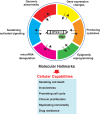Molecular hallmarks of adult T cell leukemia
- PMID: 23060864
- PMCID: PMC3444139
- DOI: 10.3389/fmicb.2012.00334
Molecular hallmarks of adult T cell leukemia
Abstract
The molecular hallmarks of adult T cell leukemia (ATL) comprise outstanding deregulations of signaling pathways that control the cell cycle, resistance to apoptosis, and proliferation of leukemic cells, all of which have been identified by early excellent studies. Nevertheless, we are now confronted the therapeutic difficulties of ATL that is a most aggressive T cell leukemia/lymphoma. Using next-generation strategies, emerging molecular characteristics such as specific surface markers and an additional catalog of signals affecting the fate of leukemic cells have been added to the molecular hallmarks that constitute an organizing principle for rationalizing the complexities of ATL. Although human T cell leukemia virus type 1 is undoubtedly involved in ATL leukemogenesis, most leukemic cells do not express the viral protein Tax. Instead, cellular gene expression changes dominate homeostasis disorders of infected cells and characteristics of ATL. In this review, we summarize the state of the art of ATL molecular pathology, which supports the biological properties of leukemic cells. In addition, we discuss the recent discovery of two molecular hallmarks of potential generality; an abnormal microRNA pattern and epigenetic reprogramming, which strongly involve the imbalance of the molecular network of lymphocytes. Global analyses of ATL have revealed the functional impact of crosstalk between multifunctional pathways. Clinical and biological studies on signaling inhibitory agents have also revealed novel oncogenic drivers that can be targeted in future. ATL cells, by deregulation of such pathways and their interconnections, may become masters of their own destinies. Recognizing and understanding of the widespread molecular applicability of these concepts will increasingly affect the development of novel strategies for treating ATL.
Keywords: ATL; HTLV-1; epigenetics; genome; miRNA; signal transduction.
Figures





References
-
- Akagi T., Ono H., Shimotohno K. (1996). Expression of cell-cycle regulatory genes in HTLV-I infected T-cell lines: possible involvement of Tax1 in the altered expression of cyclin D2, p18Ink4 and p21Waf1/Cip1/Sdi1. Oncogene 12, 1645–1652 - PubMed
-
- Annunziata C. M., Davis R. E., Demchenko Y., Bellamy W., Gabrea A., Zhan F., Lenz G., Hanamura I., Wright G., Xiao W., Dave S., Hurt E. M., Tan B., Zhao H., Stephens O., Santra M., Williams D. R., Dang L., Barlogie B., Shaughnessy J. D., Kuehl W. M., Staudt L. M. (2007). Frequent engagement of the classical and alternative NF-kappaB pathways by diverse genetic abnormalities in multiple myeloma. Cancer Cell 12, 115–13010.1016/j.ccr.2007.07.004 - DOI - PMC - PubMed
-
- Ariyama Y., Mori T., Shinomiya T., Sakabe T., Fukuda Y., Kanamaru A., Yamada Y., Isobe M., Seto M., Nakamura Y., Inazawa J. (1999). Chromosomal imbalances in adult T-cell leukemia revealed by comparative genomic hybridization: gains at 14q32 and 2p16-22 in cell lines. J. Hum. Genet. 44, 357–36310.1007/s100380050178 - DOI - PubMed
LinkOut - more resources
Full Text Sources
Other Literature Sources

